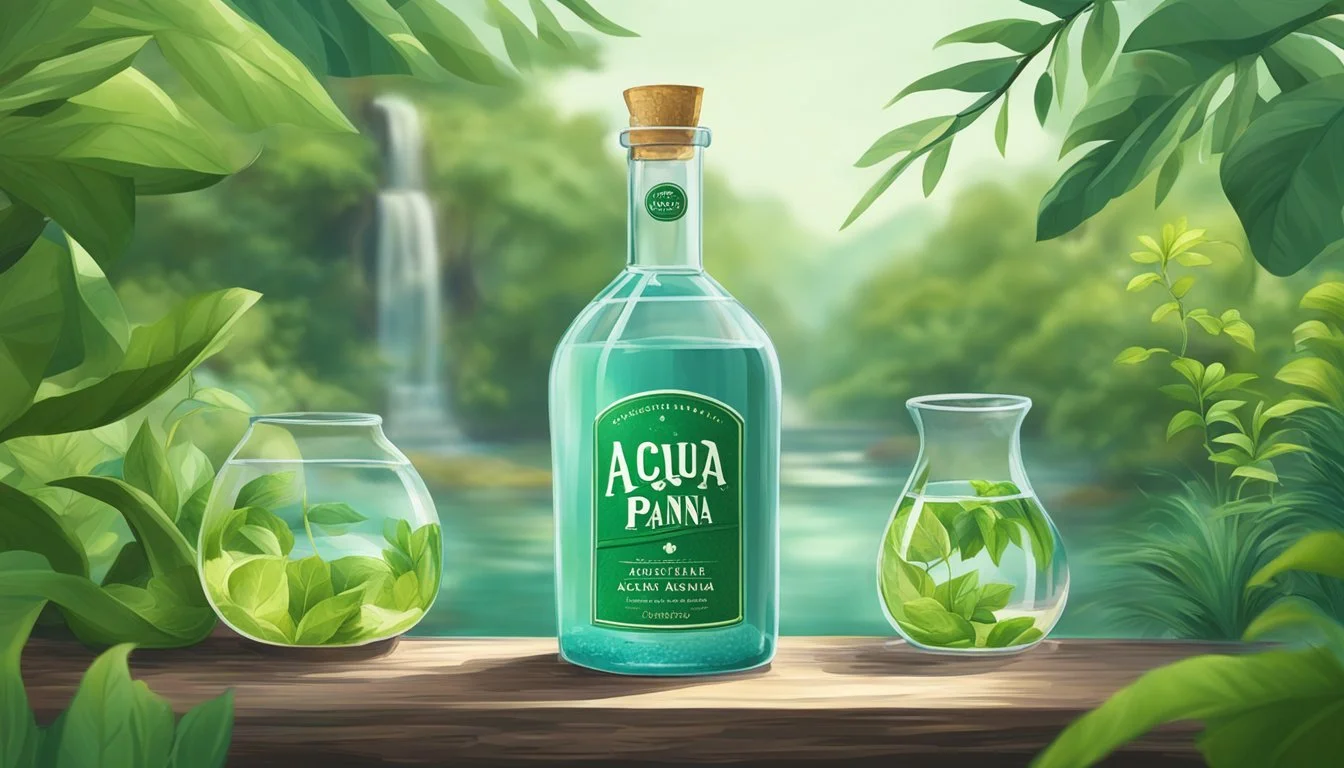Acqua Panna vs. The Well
A Comparative Analysis of Bottled Water Brands
For those seeking premium bottled water options, Acqua Panna and The Well stand out due to their distinctive qualities. Acqua Panna, sourced from Italy's Tuscany region, boasts a balanced pH level around 8.0, contributing to its smooth and delightful taste. It is often favored by those who appreciate a crisp and clean hydration experience.
On the other hand, The Well offers a different yet equally compelling profile. Known for its rich mineral content, it provides not just hydration, but also essential nutrients that can support overall wellness. This makes The Well a go-to choice for consumers who prioritize health benefits in their bottled water.
When comparing the two, it comes down to personal preference in taste and hydration needs. Ultimately, Acqua Panna provides a more neutral, refreshing taste while The Well offers additional minerals that might appeal to health-conscious individuals.
The Significance of Water Sources
Water sources play a crucial role in determining the taste, quality, and mineral content of bottled water. Both Acqua Panna and The Well's water source offer unique benefits attributed to their origins.
Origin of Acqua Panna
Acqua Panna originates from Tuscany, Italy. Its source is a natural spring located in the hills of this scenic region. This water is naturally filtered through the geological layers, which contribute to its unique mineral composition.
Originating from a pristine environment, Acqua Panna is renowned for its clean, smooth taste. The water is rich in calcium, magnesium, and silica, essential minerals that enhance its velvety texture and sweet finish.
The journey from source to bottle ensures the retention of these beneficial minerals while maintaining a neutral pH balance close to 8.0. This alkalinity makes it a preferred choice for individuals mindful of their dietary pH levels.
Understanding The Well's Water Source
The Well sources its water from an underground aquifer. This aquifer is a deep, natural storage of groundwater, often formed in regions with specific geological formations that allow for extensive natural filtration.
Water drawn from an aquifer generally exhibits a balanced mineral profile, contributing to its refreshing taste. The Well focuses on maintaining the purity of this source by implementing stringent quality controls and sustainable extraction practices.
By tapping into this deep aquifer, The Well ensures that the water is consistently free from surface contaminants. This commitment to purity and the inherent qualities of the aquifer underscore The Well’s reputation for freshness and quality.
Analyzing Water Quality
When determining the best bottled water, examining aspects like mineral content and health benefits, filtration methods, and purity is crucial.
Mineral Content and Health Benefits
Acqua Panna is known for its high quality and smooth taste, partly due to its mineral composition. Sourced from the hills of Tuscany, it is naturally alkaline with a pH of approximately 8.0. This contributes to a velvety texture that is often appreciated by consumers.
Calcium and magnesium are primary minerals found in Acqua Panna. These minerals are important for bone health and cardiovascular function. Acqua Panna's mineral content is balanced and not too high, making it a healthy choice for regular consumption.
The Well sources its water from domestic springs and undergoes rigorous quality checks. It typically contains essential minerals like sodium, which helps with fluid balance, although the levels are generally low to maintain a clean taste.
The Role of Filtration and Purity
Filtering and purification processes play a critical role in bottled water quality. Acqua Panna undergoes minimal filtration to preserve its natural minerals and maintain its distinctive taste. This minimal processing ensures that the water retains its smooth texture and subtle mineral flavors, enhancing its appeal.
In contrast, The Well often applies advanced filtration techniques to ensure the highest level of purity and safety. This includes multiple stages of filtration to remove impurities and contaminants, resulting in crystal-clear water. The rigorous filtration process ensures that the water remains free from harmful substances, providing a safe and enjoyable drinking experience for consumers.
Both brands prioritize safety and quality by conducting regular quality tests and adhering to strict industry standards. These practices are essential in ensuring that the water is not only safe to drink but also beneficial to health.
Comparative Taste Profile
In comparing Acqua Panna and The Well, notable differences in their taste profiles emerge, rooted in their unique sources and mineral content.
Flavor Influences of Acqua Panna
Acqua Panna, sourced from the springs in Tuscany, boasts a neutral pH balance typically around 8.0. This specific pH contributes to its smooth and velvety taste, which is a defining characteristic. Its mineral content results in a subtly sweet and well-rounded flavor.
Given its heritage dating back to 1564, Acqua Panna has a reputation for a clean taste with minimal mineral aftertaste, making it a popular choice for those who prefer natural water without strong mineral nuances. The water’s composition ensures it aligns with those seeking both taste and purity.
Taste Characteristics of The Well
The Well’s taste profile, on the other hand, is influenced by its mineral-rich composition. Bottled from select sources, The Well often features a more robust mineral flavor. According to sources, this taste can be more pronounced, appealing to those who enjoy water with a distinct mineral presence.
The pH levels of The Well are typically more moderated, potentially around 7.0, which further emphasizes its balanced taste. This bottled water might exhibit a slight tang due to its mineral content, offering a different experience compared to the smooth taste of Acqua Panna. The richness in minerals can also enhance its natural water profile, making it a thoughtful choice for those who lean towards pronounced taste and purity in their drinking water.
Nutritional Value and Health Considerations
Understanding the nutritional value and health aspects of Acqua Panna and The Well can provide insights into their potential benefits. Key considerations include the presence of electrolytes and the alkalinity and pH levels of the water, which influence their characteristics and impact on health.
Presence of Electrolytes
Electrolytes are essential minerals crucial for various bodily functions, such as maintaining fluid balance, nerve function, and muscle health. Acqua Panna contains a subtle blend of electrolytes including calcium and magnesium, which contribute to its smooth texture.
In contrast, The Well focuses on delivering water with a balance of sodium and potassium, essential for hydration.
A side-by-side comparison highlights:
Acqua Panna: Rich in calcium and magnesium.
The Well: Notable for sodium and potassium content.
Both brands provide beneficial nutrients, but their electrolyte profiles can cater to different health needs.
Alkalinity and pH Levels
The pH level of water is a measure of its acidity or alkalinity, which can impact its taste and health benefits. Acqua Panna boasts an alkaline pH of around 8.0, helping to neutralize acidity in the body. This can be beneficial for those seeking to balance their dietary pH levels.
The Well usually maintains a neutral pH level, close to 7.0, ideal for regular consumption without significant impact on the body's pH balance.
Water Brand pH Level Alkaline Advantage Acqua Panna ~8.0 Helps neutralize body acidity The Well ~7.0 Ideal for regular hydration without altering body pH
While both waters are suitable for daily hydration, Acqua Panna's higher pH may offer additional benefits for those attentive to their body's pH balance.
Environmental Impact and Sustainability
The environmental sustainability of bottled water depends greatly on packaging materials and the brands' commitment to sustainable practices, impacting our planet and consumer choices.
Packaging and Environmental Concerns
Acqua Panna and The Well use different packaging materials that affect their environmental impact. Acqua Panna often uses glass bottles, which are highly recyclable and have a lower chance of contributing to plastic pollution. This makes glass a more sustainable option compared to plastic.
The Well, on the other hand, primarily uses plastic bottles. While plastic is lighter and cheaper to transport, it has a significant environmental footprint, especially if not properly recycled. Concerns around microplastic contamination and the longevity of plastic in landfills further highlight these issues.
Moreover, the carbon footprint associated with the manufacturing and transportation of plastic bottles is higher than that of glass bottles.
Water Brands Commitment to Sustainability
Acqua Panna prioritizes sustainability through several initiatives. They focus on reducing their reliance on plastic packaging and aim for their production processes to be carbon neutral. Their glass bottles minimize environmental impact, but they also strive to use recycled materials whenever possible.
The Well has taken steps to improve sustainability by using recycled plastic in their bottles. They also engage in programs designed to offset their carbon footprint. However, criticisms arise around their ability to manage the long-term environmental effects of plastic.
Both brands promote various sustainability initiatives, but material choices and recycling programs determine their overall impact on the environment.
Packaging Differences
Acqua Panna and The Well differ significantly in their packaging choices, with Acqua Panna opting for traditional glass bottles and The Well favoring plastic alternatives. These packaging decisions influence sustainability and user convenience.
Benefits of Glass versus Plastic
Glass bottles, like those used by Acqua Panna, offer several benefits. They are reusable, reducing environmental impact. Glass is non-reactive, ensuring the water's taste remains unaltered. Additionally, glass bottles are often perceived as more premium and eco-friendly compared to plastic.
In contrast, The Well's plastic bottles are lighter and less prone to breakage, which can be more convenient for active lifestyles or travel. Despite these advantages, plastic is criticised for being less sustainable due to its environmental footprint. Sustainability concerns push consumers toward more environmentally friendly options, such as glass or boxed water.
Innovations in Packaging
Acqua Panna has made strides in packaging materials by offering reusable glass bottles, which further highlight their commitment to sustainability. They focus on reducing their carbon footprint while maintaining product safety and taste integrity.
The Well, while primarily utilizing plastic, invests in innovative solutions like biodegradable plastics and lightweight designs. They explore alternatives such as aluminum cans and boxed water to appeal to eco-conscious consumers.
Both brands continuously research and implement advanced packaging methods to improve sustainability without compromising product quality or consumer convenience.
Market Presence and Consumer Choices
Acqua Panna and The Well cater to different segments of the bottled water market. Acqua Panna is often associated with luxury and premium experiences, while The Well appeals to those seeking cost-effective and accessible options.
Brand Reputation and Certifications
Acqua Panna is renowned for its premium positioning and historical roots, sourced from the Panna estate in Tuscany since 1564. Acadia Panna holds certifications for purity and sustainability, reinforcing its status among luxury bottled waters. It’s a preferred choice in fine dining and available on platforms like Amazon, suggesting strong consumer trust.
The Well, on the other hand, might not have the same historical prestige but focuses on quality and accessibility. The brand emphasizes practical benefits such as affordability and is marketed to broader demographics, including students and everyday consumers. It often highlights certifications that assure safe drinking standards rather than luxury.
Affordability and Accessibility
Acqua Panna positions itself as a premium product, which reflects in its pricing. It’s typically priced higher due to its stringent quality controls and luxury branding. Availability might be limited to upscale retailers and dining venues, making it less accessible to everyday shoppers.
The Well prides itself on being a cost-effective solution. Its pricing is more accessible, making it a go-to option for everyday hydration needs. Widely available in supermarkets and online stores like Amazon, The Well reaches a broader consumer base without the premium price tag, catering to budget-conscious individuals. This market presence ensures that The Well remains a popular choice for those prioritizing both quality and cost.
Final Comparison and Recommendations
Taste:
Acqua Panna is known for its smooth and velvety texture, often described as subtly sweet and well-rounded. The Well offers a fresh and clean taste. Both waters provide a pleasant drinking experience. Preferences may vary based on the individual's taste profile.
Quality:
Acqua Panna sources its water from natural springs in Tuscany, Italy, prized for its purity. The Well's water quality is also high, sourced from pristine environments. Both brands take steps to ensure minimal contamination and high standards in bottling.
Environment and Sustainability:
Acqua Panna uses eco-friendly bottling processes and promotes sustainability initiatives in its operations. The Well also commits to sustainable practices, using recyclable materials and responsible sourcing. For eco-conscious consumers, both options show a strong commitment to reducing environmental impact.
Bottling Process:
Acqua Panna uses advanced filtration methods to ensure water purity while maintaining natural minerals. The Well employs similar rigorous processes, emphasizing cleanliness and mineral retention. These methods ensure that consumers receive high-quality water free from impurities.
Health Advantages:
Acqua Panna has a neutral pH level around 8.0, which may help maintain a balanced dietary pH. It is also low in sodium, making it a healthy choice. The Well similarly offers a neutral pH, promoting health benefits without added chemicals or excessive minerals.
Advantages:
Acqua Panna:
Sourced from Tuscany
Smooth, subtly sweet taste
Low in sodium
Sustainable practices
The Well:
Clean, fresh taste
High-quality sourcing
Emphasis on sustainability and recyclable materials
In conclusion, the decision between Acqua Panna and The Well largely depends on individual preferences relating to taste, environmental commitments, and health considerations. Both brands offer exceptional quality and uphold strong standards to meet consumer demands.




